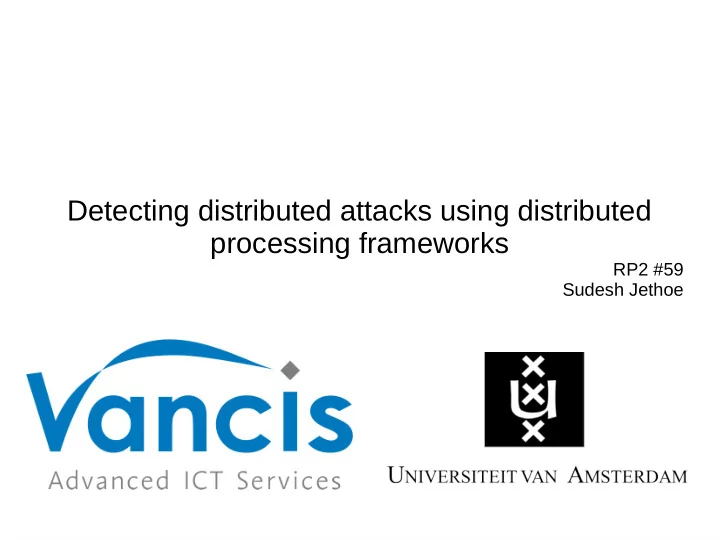

Detecting distributed attacks using distributed processing frameworks RP2 #59 Sudesh Jethoe
Overview ● Introduction ● Problem Description ● Research Questions ● Method ● Results ● Conclusion
Introduction http://www.eweek.com/security/slideshows/verisign-sees-sharp-climb-in-ddos-attack-volume-in-q2.html/
Overview ● Introduction ● Problem Description ● Research Questions ● Method ● Results ● Conclusion
Problem Description ● Analysis of large volumes of network traffic data takes time ● A lot of time ● Can we make it faster?
Solution?
Overview ● Introduction ● Problem Description ● Research Questions ● Method ● Results ● Conclusion
Research Questions Main research question: ● How can a distributed processing framework be utilized to identify network anomalies in historical netflow data? Sub questions: ● Which processing framework is best suited for identifying DDOS attacks? ● How can we distinguish anomalies in netflow data? ● Which algorithms for detecting network anomalies exist and how can they be applied in a distributed processing environment?
Overview ● Introduction ● Problem Description ● Research Questions ● Method ● Results ● Conclusion
Method 1)Review distributed processing frameworks 2)Create application for distributed processing framework 3)Implement DDOS-algorithm in application
Distributed processing frameworks
Distributed processing frameworks
Distributed processing frameworks ● Hive – Limited to querying datasets ● Pig – Extend queries with scripting and ML ● Spark – Extract data, transform, query, extendable python
Method 1)Review distributed processing frameworks 2)Create application for distributed processing framework 3)Implement DDOS-algorithm in application
Implementing Spark ● Cluster ● Dataset – 26 nodes Route Dataset Size r – 2x2TB disks 1 83,4 MiB 2 126,7 MiB – AMD Opteron 3vCPU 3 1,1 GiB – 1GB/s ethernet 4 3,1 GiB 5 10 GiB 6 41,5 GiB 7 88,2 GiB 8 99,3 GiB 9 296,4 GiB 10 444,4 GiB
Implementing Spark ● 3 methods – Traditional – Parallelised – Single MapReduce
Implementing Spark ● Traditional 1) retrieve unique intervals 2) partition the data by interval 3) for each interval create counts of packets for each found socket ● Result > 1,5 hour / 84,4 MiB
Implementing Spark ● Parallelised 1) retrieve unique intervals 2) partition the data by interval 3) Parallel: for each interval create counts of packets for each found socket ● Result ~ 10 mins / 126,7 MiB
Implementing Spark ● Single MapReduce 1) Initialize cluster 2) Read network traffic data from HDFS 3) Apply map/reduce to get flow counts for “dest IP:port:protocol:hour” 4) Filter out all counts < #threshold 5) Group results by “port:protocol” 6) Filter out all combinations < #min results 7) Normalize results by “port:protocol 8) Plot all hits for remaining “port:protocol” combinations
Implementing Spark ● Results Dataset Size (GiB) Execution Time (seconds) Rate (MiB/seconds) 0,128 28 4,57 1,1 45,6 4,07 99,3 430,4 231 444,4 / /
Results (126,7 MiB)
Results (126,7 MiB)
Results (88,2 GiB)
Results (10,0 GiB)
Method 1)Review distributed processing frameworks 2)Create application for distributed processing framework 3)Implement DDOS-algorithm in application
Implement DDOS-algorithm in application ● Weighted Moving Average x ( i + 1 ) = yx i +( 1 − y ) ^ ^ x i x i : current valueof x ^ x : estimationx y : smoothing factor
Implement DDOS-algorithm in application ● Adaptive threshold – Uses weighted average – Threshold: Multiple of expected value of the average alert if x i > threshold ∗ ^ x i
Implement DDOS-algorithm in application ● Exponential Weighted Moving Average (EWMA) ● Threshold Gap = 0, avg = X0, Max_Gap = # If Xi < AVG: update(AVG, Xi) If Xi > AVG: Alert() If Gap >= Max_Gap: Gap = 0 update(AVG, Xi) Gap +=1
Overview ● Introduction ● Problem Description ● Research Questions ● Method ● Results ● Conclusion
Results (training 126,7MiB)
Results (training 126,7MiB)
Results (84,3MiB)
Results (88,2 GiB)
Results (88,2 GiB)
Overview ● Introduction ● Problem Description ● Research Questions ● Method ● Results ● Conclusion
Conclusion ● ~ 100 GiB < 10 minutes ● Traffic from different routers require different parameters ● Traffic patterns differ per router and service
Future work ● Optimize framework to handle datasets > 100 GiB ● Test other algorithms on framework ● Apply tuned algorithms to live data ● Identify usage of irregular ports
Questions ● ?
Recommend
More recommend